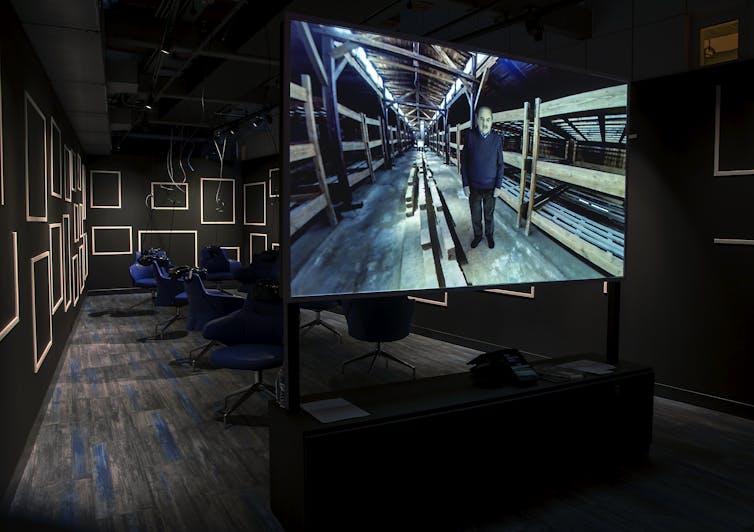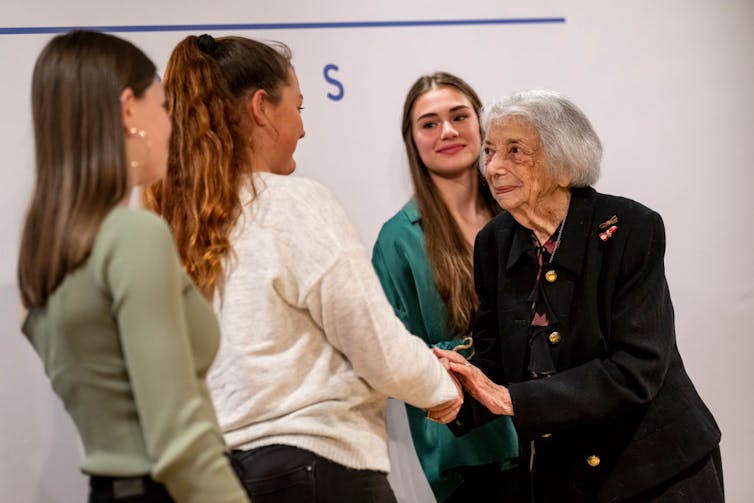Combating antisemitism today: Holocaust education in the era of Twitter and TikTok

Alan Marcus, University of Connecticut
In the era of social media, antisemitism and Holocaust denial are no longer hidden in the margins, spewed by fringe hate groups. From Ye – formerly known as Kanye West – and NBA player Kyrie Irving to members of Congress on both sides of the aisle, well-recognized personalities have echoed antisemitic ideas, often online.
Beyond high-profile figures, there are clear signs that antisemitism is becoming more mainstream. In 2021, using the most recent data available, the Anti-Defamation League reported that antisemitic incidents in the U.S. reached an all-time high. Eighty-five percent of Americans believe at least one anti-Jewish trope, according to another ADL survey, and about 20% believe six or more tropes – a sharp increase from just four years before. In addition, Jewish college students increasingly report feeling unsafe, ostracized or harassed on campus.
All of this is layered on top of a widespread lack of knowledge about the Holocaust. As International Holocaust Remembrance Day approaches – Jan. 27, the day Auschwitz-Birkenau was liberated – it is important to rethink how educators like me design lessons on antisemitism and the Holocaust.
Rather than teaching the Holocaust as an isolated event, educators must grapple with how it connects to antisemitism past and present. That means adapting to how people learn and live today: online.
Toxic information landscape
The online ecosystem where today’s antisemitism flourishes is a Wild West of information and misinformation that is largely unmonitored, distributed in an instant, and posted by anyone. Social media posts and news feeds are frequently filtered by algorithms that narrow the content users receive, reinforcing already held beliefs.
Mainstream platforms like TikTok, with soaring growth among young people, can be used to promote antisemitism, as can less well-known apps such as Telegram.
According to a 2022 report by the United Nations, 17% of public TikTok content related to the Holocaust either denied or distorted it. The same was true of almost 1 in 5 Holocaust-related Twitter posts and 49% of Holocaust content on Telegram.
An emerging danger is artificial intelligence technology. New AI resources offer potential teaching tools – but also the menace of easily spread and unmonitored misinformation. For example, character AI and Historical Figures Chat allow you to “chat” with a historical figure, including those associated with the Holocaust: from victims like Holocaust diarist Anne Frank to perpetrators such as Joseph Goebbels, Adolf Hitler’s minister of propaganda.
These sites come with warnings that characters’ responses could be made up and that users should check for historical accuracy, but it is easy to be misled by inaccurate answers.
Another potential AI hazard is deepfake videos. Media experts are warning about the potential for destabilizing “truth decay,” the inability to know what is real and what is fake, as the amount of synthetic content multiplies. Holocaust scholars are preparing to combat how historical sources and educational materials may be manipulated by deepfakes. There is particular concern that deepfakes will be used to manipulate or undercut survivors’ testimony.
Media literacy
Much of my scholarship tackles contemporary approaches to teaching the Holocaust – for example, the need to rethink education as the number of Holocaust survivors who are still able to tell their stories rapidly declines. Addressing today’s toxic information landscape presents another fundamental challenge that requires innovative solutions.

As a first step, educators can promote media literacy, the knowledge and skills needed to navigate and critique online information, and teach learners to approach sources with both healthy criticism and an open mind. Key strategies for K-12 students include training them to consider who is behind particular information and what evidence is provided and to investigate the creators of an unknown online source by seeing what trusted websites say about its information or authors.
Media literacy also entails identifying a source’s author, genre, purpose and point of view, as well as reflecting on one’s own point of view. Finally, it is important to trace claims, quotes and media back to the original source or context.
Applying these skills to a Holocaust unit might focus on recognizing the implicit stereotypes and misinformation online sources often rely on and paying attention to who these sources are and what their purpose is. Lessons can also analyze how social media enables Holocaust denial and investigate common formats for online antisemitism, such as deepfake videos, memes and troll attacks.
Learning in the digital age
Holocaust educators can also embrace new technologies, rather than just lament their pitfalls. For example, long after survivors die, people will be able to “converse” with them in museums and classrooms using specially recorded testimonies and natural language technology. Such programs can match a visitor’s questions with relevant parts of prerecorded interviews, responding almost as though they were talking to the visitor in person.
There are also immersive virtual reality programs that combine recorded survivor testimonies with VR visits to concentration camps, survivors’ hometowns and other historical sites. One such exhibition is “The Journey Back” at the Illinois Holocaust Museum and Education Center. Not only can VR experiences transport viewers to such sites in a more realistic way than traditional lessons, but they also allow learners to partially decide how to interact with the virtual environment. In interviews for my current research, viewers report Holocaust VR experiences make them feel emotionally engaged with a survivor.
Society’s ‘family tree’
People often learn about themselves by exploring their family trees, examining heirlooms passed down from ancestors and telling stories around the dinner table – helping people make sense of who they are.
The same principle applies to understanding society. Studying the past provides a road map of how people and prior events shaped today’s conditions, including antisemitism. It is important for young people to understand that antisemitism’s horrific history did not originate with the Holocaust. Lessons that lead students to reflect on how indifference and collaboration fueled hate – or how everyday people helped stop it – can inspire them to speak up and act in response to rising antisemitism.
Holocaust education is not a neutral endeavor. As survivor and scholar Elie Wiesel said when accepting his 1986 Nobel Peace Prize, “We must always take sides. Neutrality helps the oppressor, never the victim.”![]()
Alan Marcus, Professor of Curriculum & Instruction, University of Connecticut
This article is republished from The Conversation under a Creative Commons license. Read the original article.
